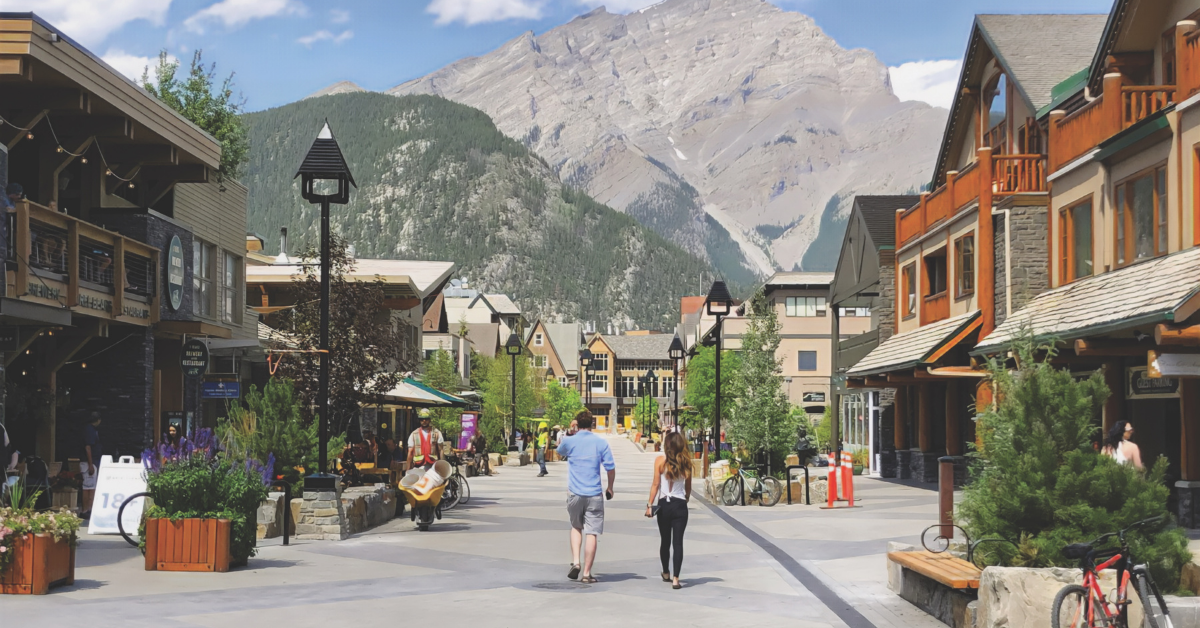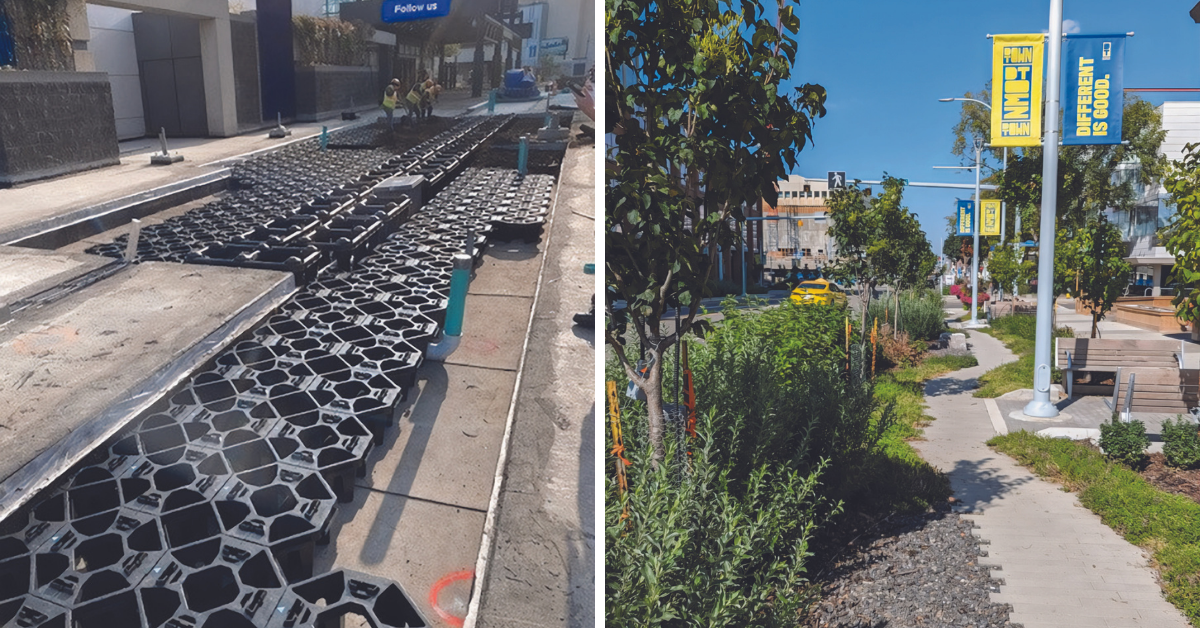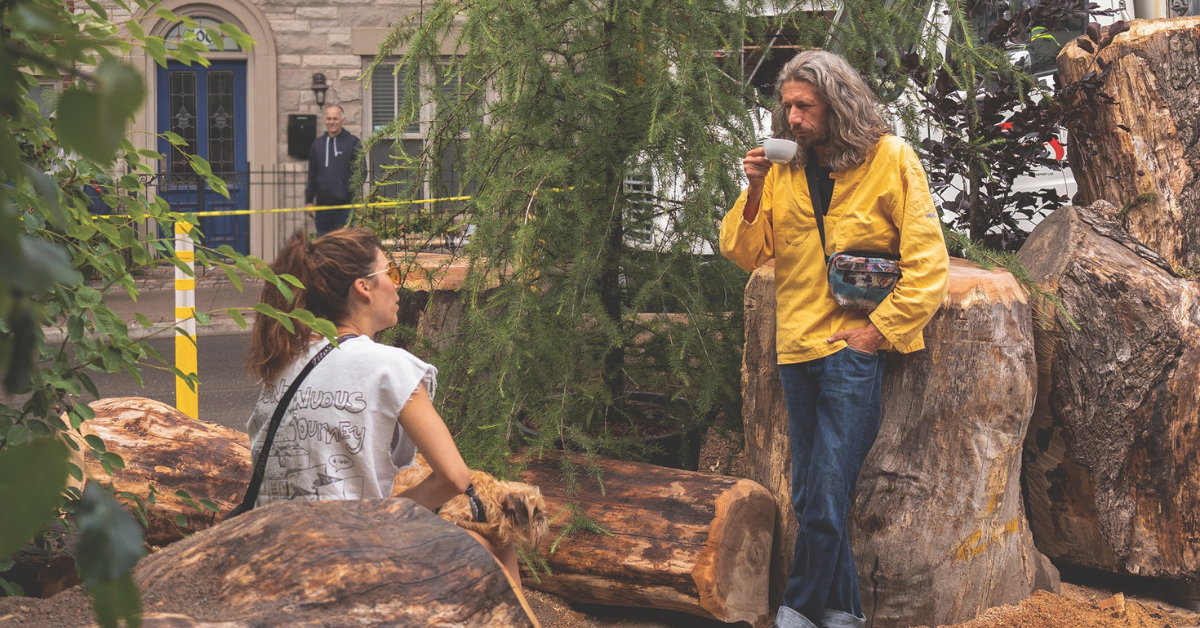May 10, 2024

How Canadians are bringing a Dutch idea to life
Woonerf: Transforming streets into shared spaces
BY KARINA SINCLAIR
How often do you add a new word to your vocabulary? Here’s a good one: woonerf. It’s a Dutch word that roughly translates to “living street.”
Historically, streets have served as bustling social hubs, but the boom of motorized traffic pushed people to the edges of these avenues. To restore community interaction and safety — creating spaces where people can meet, pedestrians and cyclists can move around freely and children can play safely — the woonerf concept emerged in the Netherlands in the late 1960s and gained traction worldwide.
Several communities have recently incorporated woonerven or living streets all across Canada. Planning, designing, building and maintaining a woonerf requires collaboration between municipal departments, local stakeholders and landscape professionals, providing many opportunities to contribute to one’s local landscape. From permanent installations to pop-up parklets, living streets have transformed barren sidewalks, empty lots and concrete corridors into lush urban destinations.
Converting a street in Banff, Alta., into a woonerf created a barrier-free and engaging community space for residents, local business and tourists.
A pedestrian paradise in Banff
In 2021, the Town of Banff invested $9.5 million to transform a downtown block into a pedestrian-friendly zone that better accommodates residents, businesses and visitors. Bear Street, which runs parallel to the main artery, Banff Avenue, was revitalized above and below ground. First, the aging sewers and water lines were replaced. Then, trench drains and soil cell beds were added to collect and filter rainfall and snow melt. “We used underground soil cells for this project because of two things,” Darren Enns, the director of planning and environment for the Town of Banff explained. “One for tree health, because we believe we’ve helped create healthier trees, but also to treat our stormwater drainage at the source so we could help the Bow River.”
These soil cells — stretching roughly eight feet wide and five feet deep below the surface — provide up to four times more soil than a standard urban street planter, allowing more room for tree roots. This also helps the tree canopies reach a mature height more quickly. Sensors in the soil cells trigger automated irrigation for the 80 new trees and other plants added to the woonerf.
Enns said a lot of thought was given to the species of trees planted, especially after noticing that dense conifers were not as welcoming as they matured. “So we learned from that and switched to a deciduous base with a much more seasonal, showy appearance,” Enns said.
Landscapers installed 37 new planter pods bordered with rock boulders, which double as public seating. Additional electrical power was installed along the street, with outlets on every pod to accommodate events and holiday lighting without generators.
Since Bear Street doesn’t serve as a main vehicular thoroughfare, planners could designate this as a shared street and make it completely level versus building the usual elevated sidewalks. Enns was fascinated to see how removing four inches of concrete curb created a very different environment. “We were worried at the start whether or not pedestrians would take ownership of the street and public space. On the very first day, in the very first hour, pedestrians moved to the middle of the street and asserted their control,” Enns said. “We had all sorts of backup plans for signage and cues to explain how to use the street, but it was intuitive, and that’s a credit to the design itself.”
Canmore, Alta.-based JP Landscaping hand installed 46,848 square feet of pavers in a diagonal pattern, which serve as a visual cue to encourage people to freely cross the street. The pattern also skillfully aligns with drainage and bollards. As an added bonus, these smooth central areas can be transformed into performance stages any time of the year, or be temporarily converted to pedestrian-only zones. In past winters, the town created a skating rink and planted mini Christmas trees in the planters.
The level surface also makes it easier for strollers and wheelchair users, and since the area has reduced traffic volume and speeds, Enns said it feels safer for all kinds of users: “We had a member of the public come and say how they love to bring their aging parent with dementia to the pedestrian zone because it was such a safe space to just stop and go slow. It’s quiet, stress free.”
Seven M Construction's installation of this project ultimately won the firm a 2023 Landscape Alberta Award of Excellence for commercial landscapes over $500,000.
Greening Edmonton's concrete jungle
In the City of Edmonton, a section of Jasper Avenue was substantially reimagined in 2022 to highlight the downtown core as a safe area for all, whether they walk, bike, drive or use transit. The goal was to support area businesses and attract visitors. “Downtown Edmonton has seen some challenges and needed some revitalization and some clean up,” said Chris Payne, project superintendent at Seven M Construction, the landscaping company responsible for the installation of the project. “It makes sense to have areas for people to enjoy rather than just a concrete jungle,” Payne said.
Similar to Banff’s Bear Street, Seven M installed soil cells, sub drainage and aeration pipes, as well as new site furniture, benches and bike racks. They also removed contaminated soil, carefully excavating around the existing utility corridor. To convert the grey concrete blank slate into something lush and enticing, they added approximately 125 caliper trees and tree grates, 1,474 shrubs and nearly 7,900 perennials.
An informal paving stone path breaks up the harsh lines of a cityscape and invites pedestrians and downtown workers to sit and relax. “Providing that little bit of a walkway and some natural areas like flattened boulders, along with the site furniture and everything else, combines into a cohesive area that people can enjoy. And as it grows, I think it can only look better,” Payne said, adding that the colourful garden beds add some “pop” while still being a functional downtown space.
Not only does the added greenery help locals find serenity amidst the hustle and bustle of downtown, Payne said it encouraged ground-level businesses to match the new and improved local vibe. “There’s still a little bit of work to do there, but I think it creates a nicer street. You see a lot of businesses, as the streets get cleaned up, investing in themselves as well, so that’s a benefit for everybody.”
The Cabbagetown Parkscape provided peaceful settings to linger in an area with busy traffic.
Creating community engagement in Toronto
Adam Bienenstock, founder of Bienenstock Natural Playgrounds in Hamilton, Ont., agreed that living streets can deeply enrich the experience for local residents and businesses. He said his team is always thinking about “how to take a section and make it alive, make it green, make it change the topography.” Bienenstock is also excited about how that space comes alive in the community. “[We want to] bring in vendors, interpreters and opportunities for engagement. Celebrate the local folks who are doing interesting things.”
The natural playground-focused design/build firm implemented its first living street project in 2012. The team transformed several blocks of Yonge Street in Toronto into a temporary Celebration Park by introducing natural elements, like trees, boulders, grass and logs. The new naturescape also included an amphitheatre, three patios and a cedar fort.
This was the proof-of-concept project that launched LivingStreets.org, a community-focused offshoot of Bienenstock Natural Playgrounds. The organization has since installed several more pop-up living streets to promote “going green” across Canada, including: Dartmouth, N.S., Laval Que., Calgary, Alta., and Vancouver and Surrey, B.C., often in partnership with TD Friends of the Environment Foundation. Bienenstock, also the founder of LivingStreets.org, said this initiative is designed to demonstrate how easy it can be, in just a few days, to unite the human and environmental potential of urban landscapes.
“For me, a living street is a tool. I’m interested in how people meet each other, how they relate with the natural environment,” Bienenstock said. “I’m interested in the relationship that nature has with our personal well-being, our ability to knock down stress and be in the moment. Our cities are uniquely designed to screw that up.”
Through the Living Streets Program, Bienenstock worked with the Cabbagetown Business Improvement Association (BIA) to install the Cabbagetown Parkscape in 2022, a project that won the 2022 TABIA Streetscaping Award and 2023 OBIAA Streetscape and Public Realm Award of Merit. Parkscape transformed 200 metres along Parliament Street in Toronto, Ont. into a natural oasis in just a few days, with 130 truckloads of soil, 3,000 tons of natural materials, 100 new street trees and shrubs and seating for up to 250 people.
“It meant creating parklets along the street and slowing down traffic by having it be serpentine instead of straight. It returned ownership of that street to the neighbourhood and away from the cars. A living street allows you that opportunity to come together, calm down and change your relationship with each other,” Bienenstock said.
According to Bienenstock, adding trees and other natural elements helps reduce the heat island effect, lowering street level temperatures by up to 20 degrees.
Bienenstock also said a survey done with local stores in the area reported a 50 per cent boost in foot traffic. “And we saw a 56 per cent increase in the amount of money that they [shoppers] spent, so not only did they linger more, but they spent more money per capita while there.”
Matthew Mohan, executive director of the Cabbagetown BIA, was delighted to see a return to the in-person stopping experience for local businesses. “One impact of COVID-19 was that people were setting their sights more on Walmart and Amazon when choosing where to spend their money,” Mohan said, explaining that Parkscape was imagined as a way to get people lingering in the high-density, central Toronto neighbourhood again. “I think that's really what you need to do, is provide an experience to visitors, young and old. The Cabbagetown neighbourhood does not have a large community gathering space like some neighbourhoods might have, so this provided us with space that we can program with arts, with live music, that we can give back to our business community and say, ‘Hey, if you want to connect with customers, if you want to forge organic connections, if you want to dabble in what I like to call experiential shopping, let’s do it.’”
Bienenstock reflected on the positive effect the Parkscape woonerf had, both for the community and himself. “There's so much cynicism out there, like, there’s this dystopian future that we all face if we don't get it right,” Bienenstock said. “This is a hopeful thing to do. I have consistently had my faith renewed in humanity when we do these things. I've seen more kindness happen in these communities where people are in close quarters with one another than I have in the sorts of spaces where people are hiding from one another. As long as you're doing this in partnership with the people who are there, and you go in knowing you'll probably have to tweak a few things, then you will be surprised at how well it gets embraced. So look for those opportunities, figure out how to animate a space, and the community will thank you for it.”
What's in a woonerf?
Woonerven have a few important characteristics:
MIXED USE
These spaces integrate the needs of residents, visitors and local businesses to create a vibrant and diverse environment.
These spaces integrate the needs of residents, visitors and local businesses to create a vibrant and diverse environment.
SHARED SPACE
In a traditional woonerf, there are no distinct markings between pedestrian walkways and car or bike lanes. The space is shared with mutual respect. Barriers, like curbs, are usually not present, but paving stones often replace asphalt or concrete surfaces to delineate areas
In a traditional woonerf, there are no distinct markings between pedestrian walkways and car or bike lanes. The space is shared with mutual respect. Barriers, like curbs, are usually not present, but paving stones often replace asphalt or concrete surfaces to delineate areas
LOW SPEEDS AND TRAFFIC CALMING MEASURES
To improve the safety of cyclists and pedestrians, motor vehicles are limited to very low speeds. Curving, narrow lanes, speed bumps and landscaped areas are designed to introduce a meandering path to further slow traffic and demand driver focus.
To improve the safety of cyclists and pedestrians, motor vehicles are limited to very low speeds. Curving, narrow lanes, speed bumps and landscaped areas are designed to introduce a meandering path to further slow traffic and demand driver focus.
LANDSCAPING AND GREENERY
Lush tree canopies, shrubbery, garden beds and other natural elements like logs or boulders for ample seating enhance the aesthetic appeal and create a place worth lingering. Trees and boulders can also provide a physical barrier between vehicles and pedestrians.
Lush tree canopies, shrubbery, garden beds and other natural elements like logs or boulders for ample seating enhance the aesthetic appeal and create a place worth lingering. Trees and boulders can also provide a physical barrier between vehicles and pedestrians.
SOCIAL INTERACTION
Living streets encourage social interaction among residents and visitors, and create space for extended patios, pop-up events, live performances and other positive opportunities to entice people to the area.
Living streets encourage social interaction among residents and visitors, and create space for extended patios, pop-up events, live performances and other positive opportunities to entice people to the area.
Overall, woonerven prioritize people over vehicles, creating inclusive and livable spaces that promote sustainable transportation and community interaction.


